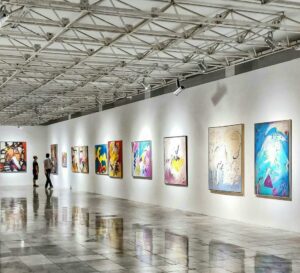
While inflation rates rise and markets falter, the art market continues to boom. After COVID, fairs are taking place again, art lovers can travel, and exhibitions are being visited. However, Corona and the rapid digitalization have contributed to a rapid change in the art market. The requirements of buyers have changed, as well as the opportunities to find and address buyers. The business is now more international and digital. The rapid change is overwhelming as well as promising!
What marketing channels are interesting and relevant for galleries and art dealers? What are the biggest challenges? The Marketing Report of the company Hubspot for the year 2023 shows:
The biggest challenges that companies worldwide will face in 2023 are generating traffic and leads.
What does that mean?
Reaching as many people as possible and generating their data or information so that they can be contacted and, ideally, “converted” into customers.
Lead generation can be done in two ways: digitally or analogously.
Digitally, by directing people to one’s own website through ads on Google, social media, or through digital clippings (interviews, reports). Ideally, to a page that matches the ad or clipping in content. And where the visitor is then visibly invited to leave their contact information (name and email).
Analogously, one should try to generate contact information at every opportunity where one encounters potential art enthusiasts.
By asking the conversation partner for their business card at events or fairs, which is the classic way. Or by laying out a list at the opening.
But this is not the most sophisticated way of generating leads: who voluntarily signs up for a list that is lying around somewhere in the room? Is someone keeping an eye on that happening?
Have you ever tried to station a colleague at the entrance of the gallery who welcomes every visitor and, as a condition for entry, enters their contact information directly into the gallery’s database? Via laptop or iPad? The visitor can even do it himself. He should click the checkbox to receive the newsletter, too. Win Win! This is already such a common practice at many events, so why shouldn’t you adopt this procedure for lead generation for your gallery?
I highly recommend brainstorming as a team for half an hour, identifying “lead generation opportunities”. And thinking about how to react in each situation or opportunity to achieve the goal of getting the data of the respective person.
What approach is convincing and charming?
So that it sounds like a real opportunity? “We have a pre-event in two weeks in a small setting and I would love to invite you.” “Do you already know our limited special editions? We only sell them to our customer base. I would be happy to add you to our database so that you automatically receive an email when there is a limited edition again.”
Keep brainstorming, there are so many convincing arguments.
This is just a brief overview of the possibilities that exist for lead generation. They are diverse and it is very worthwhile to always keep in mind that contacts in the art market form the basis of your business model.
Art is a product that you don’t buy en passant, some customers take years before they finally buy a piece from you. So make sure that customers are always reminded that you exist!












